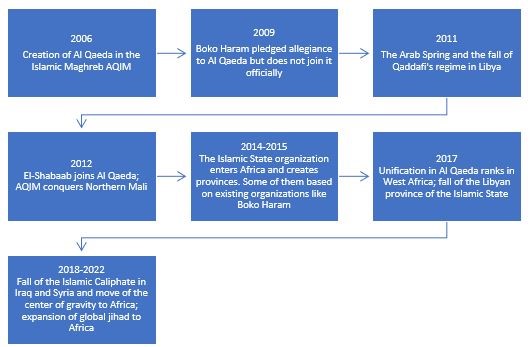Processes and Trends of Global Jihad on the African Continent
On May 11th, 2022, the anti-IS international coalition addressed the jihadi organizations’ expanding footprint in Africa as a growing threat to world security. As a rule, the presence of jihad on the African continent has been on the rise since the early 2000s. It grew thanks to basic African characteristics such as lack of governability, problematic political culture, corruption, and weak socio-economic position. The strategy employed by global jihadi organizations in Africa includes Dawah activity alongside enforcement of Sharia law on the local population in regions that lack state security forces presence and therefore are at the mercy of the terrorist organizations. With this state of affairs, the territorial and ideologic spread of the terrorist organizations without a massive counter effort is almost unavoidable.
Global jihadi organizations managed to leverage the violent conflicts in Africa and direct them to serve their immediate and long-term goals. Africa experienced 25 state-based armed conflicts in 2019 – the highest in the continent since 1946[1]. Of the above, more than a third had IS and al-Qaeda identified groups involvement that was responsible for 56% of the violence against civilians in that year[2].
There are a few major marks that make up a central layer in understanding the development of global jihadism in Africa: the formation of AQIM in 2006, the Boko Haram pledge of allegiance to al-Qaeda without having been formally accepted to the latter, the eruption of the Arab Spring in 2011, the collapse of Libya in 2011, al-Shabbab joining al-Qaeda in 2012, al-Qaeda and allies taking over northern Mali in 2012 and the French military involvement in 2013, the Egyptian coup in 2013 when the military deposed Moursi. Having said that, it seems that the most significant change began in 2014 when IS entered Africa, which caused a major expansion of terrorism in the continent as well as terrorist activities emanating from the violent IS-al-Qaeda rivalry and competition for territories, resources, and influence.

Among global jihadi organizations, one can observe two trends that typify their African activity: (i) the search for territories: al-Qaeda and IS, whose vision is the formation of an Islamic Caliphate have found themselves, after their losses in the middle east (Iraq and Syria) and Asia, in a complex operational reality that requires them to focus on terrorism and guerilla warfare and constantly search for territories to establish themselves in. It is clear that when an opportunity to physically take over a territory presents itself, they will not hesitate to take it (especially IS) and Africa provides ample such opportunities. These days, al-Qaeda and IS control territories in Somalia, Nigeria (north east Nigeria and Lake Chad regions), Mali and Mozambique (Cabo Delgado district) and subjected the local population; (ii) the treatment of the local population: whereas al-Qaeda takes a pragmatic stand and tends to collaborate with the locals based on common interests IS takes an extreme and brutal approach and demands full compliance with Sharia law from the local population – a refusal is met with harsh punishment and violence.
The counter-terrorism activity led by the west (mostly France which is currently being phased out by Germany) together with the state militaries of the continent who are being affected by the phenomenon, has a significant influence on the terrorist organizations modus operandi in the continent. For example, al-Qaeda who used to perpetrate complex attacks on western targets changed its modus operandi to low intensity attacks on security forces (be it local. Regional or international).
The war on global jihad in Africa is becoming more complex these days for multiple reasons, such as the Domino Effect causing internal conflicts to spill over to neighboring countries, lack of cooperation among member states in the joint task forces due to narrow state interests, and more. Alongside that, changes in the western powers that are active in Africa’s strategy are taking place and emanate inter alia from the reduction of French military presence, increased Russian presence and caliber due to Wagner Force’s involvement, multiple organizations, and their online activity, the willingness to start a dialogue with the latter and more. It should be noted the involvement of the international community fluctuates, sometimes significantly, which leaves many countries alone and ill-equipped in the fight against terrorism and leads in many cases to negotiations with the terrorists and an acceptance of Sharia law in the territories under their control (e.g., in Mali).
[1] Thérèse Pettersson & Magnus O’berg, “Organized violence, 1989–2019,” Journal of Peace Research Vol. 57(4), 2020, pp. 597–613. https://journals.sagepub.com/doi/pdf/10.1177/0022343320934986
[2] Ibid






